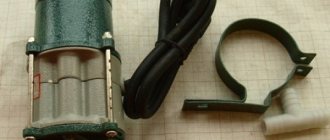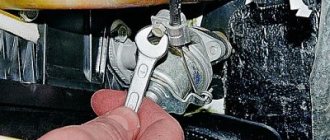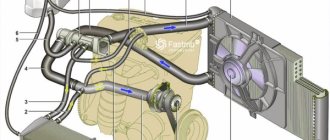Despite the fact that VAZs can hardly be called ideal cars, their popularity is growing every year. One of the obvious disadvantages of the VAZ-2101 is the stove. It slowly warms up the interior, causing the windows to remain foggy for a long time. It is uncomfortable and cold to be in the car at this time. But if there is a desire, this drawback can be, if not eliminated, then minimized. Modification of the VAZ-2101 stove with your own hands can be done in at least three ways.
VAZ-2101 is one of the most popular domestic cars in our country
What does the stove consist of?
Before you start improving the stove, you need to understand what elements it consists of. Any VAZ stove consists of:
- radiator;
- air flow distributor;
- three-blade or 5-blade fan and its shell.
After the air is cleared of moisture, it enters the heating system. The steam then comes out. There is a device above the dashboard that allows some of the air to escape when driving.
The heating housing is located in the interior of the car: it is fixed to the partition with the engine.
The heater radiator has inlet and outlet channels. These channels are connected to each other by tubes. The first tube has a built-in heating valve that regulates the supply of cooling liquid. Using a lever located on the dashboard, the flow of fluid into the machine's ventilation system is reduced or increased.
At the bottom of the radiator there is a heating system fan with a small motor that allows you to adjust the fan speed (there are two speeds in total).
The exhaust device allows the incoming air to be distributed throughout the cabin.
In order for the improvement of the VAZ-2101 stove to be justified, it is necessary to understand why the stove is not working well. If you are satisfied with your car, the stove is working properly, but you want to improve its performance, then it’s time to do tuning.
How to improve the VAZ-2101 stove with your own hands: three ways
Despite the fact that VAZs can hardly be called ideal cars, their popularity is growing every year. One of the obvious disadvantages of the VAZ-2101 is the stove. It slowly warms up the interior, causing the windows to remain foggy for a long time. It is uncomfortable and cold to be in the car at this time. But if there is a desire, this drawback can be, if not eliminated, then minimized. Modification of the VAZ-2101 stove with your own hands can be done in at least three ways.
Refinement by sealing joints
The first method is the simplest, but it will not bring big changes to the interior temperature. It consists of sealing the air outlets, so that air will flow better into the cabin.
This will allow you to optimally adjust the air flow, and the windows will be cleared of steam and icing faster. Sealing all existing connections helps to avoid unnecessary air loss, but this does not make the car any warmer.
If this modification is not enough for you, then it’s time to take the bull by the horns and tune the entire stove. It may sound scary, but in fact, modernization is not as difficult as it might initially seem.
Necessary diagnostic measures
It probably won’t be difficult for the driver to determine that the heating system has failed. The following signs will indicate the need to replace the heater radiator on a VAZ 2114:
- There is a significant temperature difference between the pipes for heat supply and removal.
- The heating system works with obvious interruptions. Heat simply does not flow into the cabin.
- You can observe a leak from the heating circuit. Antifreeze will leak from the radiator.
Repairs should not be put on the back burner, especially if the onset of persistent cold weather is just around the corner. If the heat generator is faulty, the heater radiator on the VAZ 2114 needs to be replaced.
This is interesting: Repairing car thresholds with your own hands
Improvement by replacing the fan
Since the radiator in a VAZ gives off a sufficient amount of heat, poor interior heating is associated with deficiencies in the fan. Simply put, there is not enough air to heat the entire interior of the car.
To solve this problem, it is worth replacing your fan, which is too small and not productive, with a better fan - from a VAZ-2108 or VAZ-2109, which have a higher rotation speed.
Refinement of the VAZ-2101 stove is carried out in several steps.
Step-by-step instruction
- In the cabin, we remove the shell of the lower part of the heating, where the fan is located.
- We remove, in fact, the fan, which we will no longer need.
- If you install a part from a figure eight, you need to cut the ridge that supplies air to the floor of the car.
- We remove the fan with two blades, since a fan with five blades will work instead.
- Don’t forget to check the new fan before installation - connect it and see if the blades move and there is air flow.
- We fix the new device instead of the old one and securely fasten the entire structure.
- Along with the fan, it is worth reinstalling the resistor, buttons and regulators - we also take them from the figure eight. This must be done, since due to the difference in currents the elements will quickly become unusable.
Tuning the VAZ-2101 stove, based on replacing the fan and other elements, although it will not make the stove work quieter, will allow it to heat the interior faster and better.
How to improve the VAZ-2101 stove with your own hands: three ways
Despite the fact that VAZs can hardly be called ideal cars, their popularity is growing every year. One of the obvious disadvantages of the VAZ-2101 is the stove. It slowly warms up the interior, causing the windows to remain foggy for a long time. It is uncomfortable and cold to be in the car at this time. But if there is a desire, this drawback can be, if not eliminated, then minimized. Modification of the VAZ-2101 stove with your own hands can be done in at least three ways.
Refinement using a new snail
To radically change the airflow of the stove and make it quieter, you can install a snail from the VAZ-2108 on the VAZ-2101.
What to buy
To do this you will need:
- New airflow mode switch.
- Resistance from a VAZ-2108 car.
- Snail from VAZ-2108.
- Wires, bolts, nuts, aluminum or any other corners.
- Thick plexiglass for the box.
- Industrial hair dryer to bend plexiglass.
Work step by step
As a result, we will get an improvement in all heating indicators - the cabin will be warm, and the most pleasant thing is that the noise will be significantly reduced.
- We make a housing for attaching the “snail” from plexiglass. That is, we cut it, bend it with a hair dryer, getting the desired shape. To reduce the size of the case, you can cut off the snail plugs.
- The side walls can be made of duralumin (1.5 mm thick). If cracks or crevices appear in the joints during work, they should be sealed with silicone sealant.
- We make collapsible air channels through which the flow will go to the air duct openings.
- Turns must be made smoothly to reduce air resistance in the flow and direct the air straight.
- If you want to bring airflow to your feet, make slots with flaps in the right places. If desired, you can install a variable resistor for adjusting the speed of the cochlea instead of the backlight brightness resistor.
If you do everything correctly, you will get a stove that operates almost silently, especially at low speeds. Despite the large number of bends in the design, the air flows will be sufficient to quickly heat the interior, and the second and third speeds can be turned on only in emergency cases - when you need to heat the interior very quickly.
Therefore, if you are not satisfied with something in the VAZ heating system, try to modify it. And you will succeed!
Most often, a malfunction of the heater radiator is detected when a puddle of antifreeze or water forms under the feet of the driver or front passenger, or when you turn on the heater in winter, instead of warm air, you get a stream of cold air, and again a puddle of antifreeze in the cabin.
Also read on the website: ignition system for injection VAZ 2107
The reason for this is a leak in the car's heating system. The result of such a malfunction is a spoiled mood and cool temperature in the cabin. This problem can be easily corrected on your own. For some VAZ models it will take very little time - VAZ-2101, VAZ-2102. Replacing the stove in a VAZ-2105, 2106, 2107 will require more fuss; repairing the heating system on these cars is not much different, but things are a little more complicated with the radio panel. In this article you will find useful information and guidance on replacing the heater radiator of VAZ cars.
First of all, you need to find out the reasons for the malfunction of the car heating system:
1. Antifreeze leak. There may be several reasons for an antifreeze leak in the car interior; they can be identified by visual inspection: a rusted heater radiator, a metal pipe, or a heater faucet. If your problem lies in the stove pipe or tap, then they can be replaced without disassembling the central panel and radiator casing. In this case, repairs will not require much effort and time. If it happens that the cause of the leak is a rusted radiator, then there are two options to deal with this problem. If you have a copper radiator installed, then you can solder it and tin it. You can do this yourself if you have the necessary skills, or find a master. If you have an aluminum stove radiator installed, then it would be most advisable to replace it with a new one, since such radiators usually cannot be repaired.
Replacing the heater radiator on a VAZ-2101, VAZ-2102, VAZ-2106, VAZ-2107 car
Motorists often remember about the heater radiator only when the autumn-winter period begins. No, there are times when they remember him earlier. For example, the unexpected appearance of antifreeze or water (depending on what is poured into the cooling system) under the feet of the driver or front passenger. The reason for this phenomenon is a leak in the car's heating system. But, most often, the driver learns about the malfunction of the heater radiator only when cold weather sets in. When you want warmth and comfort in the car interior. You pull the heater switch knob towards “heat”, turn on the fan and suddenly, instead of a warm flow of air from the air ducts, you get a flow of cool air or another option – the formation of a puddle of antifreeze in the car’s interior. And as a result, a spoiled mood and a cool, uncomfortable environment in the car.
But, everything can be fixed (for any car) and quite in a short period of time (this is said about the VAZ-2101 and VAZ-2102 ). In principle, replacing the heater radiator and other troubleshooting of the heating system on other Zhiguli - VAZ-2105, VAZ-2106, VAZ-2107 - is not much different, a little more fiddling with the radio panel (bar), but this article will describe the process repair of the heating system and replacement of the heater radiator on the VAZ-2101, VAZ-2102.
Causes of heating system malfunction:
- The cause of an antifreeze leak in the car interior may be a rusted heater radiator or a metal pipe or heater tap . The exact cause can be determined by visual inspection. If the whole “trouble” lies, for example, in the stove tap or pipe, then they can be replaced without disassembling the radiator casing and the “Bar” panels. If the culprit of the coolant leak is the radiator itself, then there are two options for solving the problem. First, if you have a copper radiator (an old model), it can be repaired - cleaned, soldered, tinned, etc. The main thing is to find a specialist - a radiator technician. The second option is that you have an aluminum heater radiator . Everything is simpler here, it is better to replace it with a new one, it cannot be repaired.
- When the heater is turned on, cold air continues to blow from the air ducts. The reason is a violation of the circulation of coolant in the car system, due to the fault of a non-working heater tap (it is constantly closed) or the radiator itself is “clogged”. If the faucet is jammed, it should be replaced, but point “1” of this article will help us choose the right solution for the radiator (see above).
What are the risks of self-installation?
If, say, in a VAZ 2101 car this hub mechanism is easily accessible, then in cars of modern brands it can be difficult to get to. The second difficulty is the fragility of modern mechanisms, since practically all modern faucets are structurally made of ceramics or special types of plastic, which are not afraid of corrosion, but require a delicate approach. In order not to aggravate the problem and not damage the heater stove, it is better to contact a company that will provide professional replacement of the heater tap. Such an enterprise is Time Service.
Our offers
Our car service has a full-fledged technical base to provide all types of repair and restoration work. If necessary, you can perform all additional types of car maintenance at our service station. The main advantage of the services is that all spare parts and mechanisms can be purchased at the Time Service store. If you decide to replace the heater tap with us, you do not need to worry about looking for spare parts and components - everything you need is purchased locally. Long-term cooperation with regular suppliers allows us to provide optimal prices. Replacing the faucet, the price of the part and a set of gaskets depends on the make of the car and the complexity of installation. We provide a guarantee for all services!
Causes of car radiator failure and repair
The most common cause of radiator failure is a broken heater valve. Either it doesn't turn, or the radiator is clogged. We think you can replace the faucet without any prompting from us. Now let’s talk about how to install a new radiator.
Gather the tools: Phillips and regular screwdrivers, open-end and socket wrenches "7", "8" and "10", silicone sealant, coolant and rubber gaskets.
1. Drain the coolant from the engine block, although this is not necessary.
2. Unscrew the rubber seal.
3. Remove the radio receiver (panel) in the passenger compartment, which is usually secured with two self-tapping screws.
4. Using a screwdriver or wrench, unscrew the drive cable fasteners and disconnect the radiator valve from the cable.
5. Find the 4 spring clips on the fan casing and remove them using a screwdriver. Having lowered the casing down, tilt it to the left, but not too much, as the motor power wires will interfere with you.
6. Remove the radiator from the casing.
7. Inspect its metal tubes and tap. The metal should not have too obvious signs of corrosion. There should also be no leaks.
8. It is advisable to replace the faucet, and also do not forget to change the rubber gaskets, even if outwardly they do not seem worn out: why do the same work after a while?
9. Lubricate the gaskets with silicone sealant, and then screw the outlet pipe and tap to the radiator. It is advisable to lubricate the radiator tubes with sealant before the rubber hoses supplying coolant are connected to them.
10. Reassemble in reverse order. When everything is done, fill the radiator with antifreeze, start the engine and check the tightness of the connections of the pipes and hoses.
Pay attention to all the plastic parts of the heating system, or more precisely, to the plastic tanks that are located on the sides of the heater “core”. Over time, the tanks crack, and although these cracks are almost invisible, liquid will still constantly leak onto the floor from the tank. If you turn a blind eye to constant puddles, then all this may end in car engine failure. This problem affects most cars, even the most modern ones. There is, of course, the option of installing metal tanks, but, firstly, they cost the same as the entire radiator, and, secondly, metal tanks, according to manufacturers, cannot be repaired.
Preparation
If the stove needs repair, then before replacing its radiator you should prepare everything necessary.
- sets of wrenches, both open-end and socket;
- hacksaw blade;
- coolant collection tank (it must be completely drained);
- silicone based sealant;
- wiping ends or rags.
At the same time, it is advisable to replace the pipes leading to the heater. Over time, they crack and also begin to leak antifreeze.
Next, care should be taken to empty the cooling circuit. Without this procedure, it is impossible to dismantle the main element of the stove. The standard method is used here. The coolant is first drained from the main radiator, and then from the cylinder block. It makes sense to reuse the fluid only if more than a quarter has passed since its last replacement.
After this, the air filter and the pipe leading to it, as well as the battery, are dismantled in the engine compartment. Only then will you be able to gain access to the hoses leading to the stove. Loosen the clamps holding them in place, place the container and remove - there is usually about a liter of antifreeze left in the pipes.
Near the hoses, in the wall between the passenger compartment and the engine compartment, there is another nut - it secures the retaining plate located in the cabin. Unscrew it - otherwise it will interfere with removing the radiator. Move into the cabin, here you need to remove the accelerator pedal (three bolts hold it in place), and before that the cable drive is removed from it.
When all the described work is completed, the decorative panel located on the right side of the center console is dismantled. On the 1st Kalina you will have to raise the brake pedal as much as possible. To do this, you need to completely unscrew its rod.
What to do if the radiator is leaking?
You sit behind the wheel, and you have to chatter your teeth, trying to turn on the heating harder. But it was not there! The cold is the same, and even a puddle from the radiator has formed under my feet. This situation is familiar to every tenth car owner, and all because the sled, according to the saying, had to be prepared in the summer.
Fortunately, this problem can be fixed fairly quickly. Let's start with what could be the reason for antifreeze leaking from the stove? It is hidden either in a rusted heater, in a stove tap or in a metal pipe. The damage can only be determined by inspection.
If the problem was rooted in the tap or pipe, then the situation is quite simple. You don't even have to disassemble the bar panel and radiator casing. However, if the fluid leak is due to a faulty radiator, you will have to solve the problem in one of two ways.
If your car was equipped with an old-style stove (copper radiator), then it should be cleaned, washed, soldered and tinned. Usually it is not so easy to cope with this task yourself, and therefore it is recommended to look for a car specialist specifically “for radiators”.
If the radiator turns out to be made of aluminum, then it is unlikely to be repairable. Experts advise not to patch or repair anything, but to immediately run to buy a new heater.
Heater design features
It must be said that the eighth and ninth family of VAZ cars have an identical heating system. In each case, the heat source is the main element of the car, which is represented by the engine. But the generated heat still needs to be conveyed, as they say, to the consumer. In this case, the coolant is antifreeze, which is supplied to the cooling system. It warms up the stove radiator. He himself is in a closed casing. It is blown by a stream of air, which is pumped by the heater turbine.
There is an air duct for warm air to enter the cabin. If the heater radiator is cold, then we can definitely say that it is “sick.” This unpleasant situation can occur in all VAZ cars without exception. If the clogged radiator of stove 2114 is made of copper, then it will still last for some time. The case with an aluminum radiator requires immediate replacement.
This is interesting: We reduce diesel fuel consumption on our own











